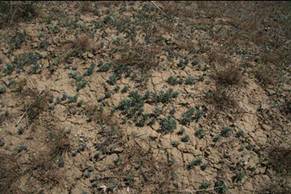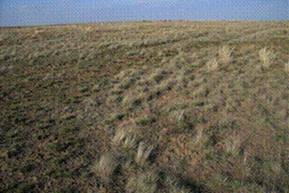Soils, groundwater and natural vegetation
The territory of Pallasovsky District is composed of thick slightly saline heavy loams deposited as a result of the Caspian Sea Quaternary transgressions.
Groundwater in this region being a receiver of surface water has a depth and concentration highly correlated with micro-relief. Under micro-depressions the surface of groundwater is convex with a depth of about 2 - 5 m and mineralization of about 0.3-1.4 g/l. Under micro-elevations the surface of ground water is concave with a depth of about 3 - 9 m and mineralization about 4-17 g/l.
The meso-elevations are occupied by solonchakous solonetz soils (>50 % of the plain) under desert Artemisia pauciflora associations. The slopes of meso-elevations (about 25 % of the plain) are occupied by light-chestnut solonetz face soils under dry-steppe vegetation (Pyrethrum associations). The meso-depressions are occupied by meadow-chestnut soils developing under form-grassy steppe vegetation with predomination of Festuca sulcata (Fig. 6, 7).
 |
 |
 |
a. solonchakous solonetz soils in meso-elevations |
b. Light-chestnut solonetz face soils in meso-elevations |
c. Meadow-chestnut soils in meso-depressions |
Fig.7: Soil and cover types at meso-elevations
Typical land cover is grassland (with spots of cropland, Fig. 4, 5) in the form of hyper-halophyte and halophyte vegetative communities in the desert zone and zonal communities of deserted steppe (Fig. 7, 8).
 |
 |
a. Vegetation in desert zone |
b. Vegetation in deserted steppe |
Fig. 8: Natural vegetation cover.